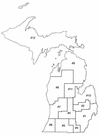Molecular analysis of glycopeptide-resistant Enterococcus faecium isolates collected from Michigan hospitals over a 6-year period
- PMID: 9774583
- PMCID: PMC105319
- DOI: 10.1128/JCM.36.11.3303-3308.1998
Molecular analysis of glycopeptide-resistant Enterococcus faecium isolates collected from Michigan hospitals over a 6-year period
Abstract
The purpose of this study was to evaluate the molecular relatedness of clinical isolates of glycopeptide-resistant Enterococcus faecium isolates collected from hospitals in Michigan. A total of 379 isolates used in this study were all vancomycin-resistant E. faecium isolates collected from 28 hospitals and three extended-care facilities over a 6-year period from 1991 to 1996. For the 379 isolates, there were 73 pulsed-field gel electrophoresis (PFGE) strain types. Within strain types, there were as many as six restriction fragment differences. Most isolates (70%) belonged to six strain types, which were designated M1 (36%), M2 (3%), M3 (18%), M4 (6%), M10 (4%), and M11 (3%). PFGE strain M1 was cultured from 135 patients in 13 hospitals during the period 1993 to 1996. Strain type M2 was cultured from 11 patients in two hospitals during the period 1991 to 1992 and was not observed after 1992. Strain type M3 was cultured from 70 patients in 10 hospitals during the period of 1994 to 1996. Both M4 and M10 were cultured from 23 patients in three hospitals and from 15 patients in two hospitals, respectively, during 1995 to 1996. M11 was cultured from 13 patients in four hospitals during 1996. A total of 23 of 28 hospitals had evidence of clonal dissemination of some isolates. Plasmid content and hybridization analysis done on 103 isolates from one hospital and two affiliated extended-care facilities indicated that the strains contained from one to eight plasmids. Mating experiments indicated transfer of vancomycin resistance from 94 of these isolates into plasmid-free E. faecium GE-1 at transfer frequencies of <10(-9) to 10(-4). Gentamicin resistance and erythromycin resistance were cotransferred at various frequencies. A probe for the vanA gene hybridized to the plasmids of 23 isolates and to the chromosomes of 72 isolates. A probe for the vanB gene hybridized to the chromosomes of 8 isolates. The results of this study suggest inter- and intrahospital dissemination of vancomycin-resistant E. faecium strains over a 6-year period in southeastern Michigan. The majority of isolates studied belonged to the same few PFGE strains, indicating that clonal dissemination was responsible for most of the spread of resistance that occurred.
Figures




Similar articles
-
Role of transposon Tn5482 in the epidemiology of vancomycin-resistant Enterococcus faecium in the pediatric oncology unit of a New York City Hospital.Microb Drug Resist. 1999 Summer;5(2):113-29. doi: 10.1089/mdr.1999.5.113. Microb Drug Resist. 1999. PMID: 10432272
-
vanA and vanB incorporate into an endemic ampicillin-resistant vancomycin-sensitive Enterococcus faecium strain: effect on interpretation of clonality.J Clin Microbiol. 1999 Dec;37(12):3934-9. doi: 10.1128/JCM.37.12.3934-3939.1999. J Clin Microbiol. 1999. PMID: 10565910 Free PMC article.
-
Clonal spread of vancomycin-resistant Enterococcus faecium between patients in three hospitals in two states.J Clin Microbiol. 1993 Jun;31(6):1609-11. doi: 10.1128/jcm.31.6.1609-1611.1993. J Clin Microbiol. 1993. PMID: 8315004 Free PMC article.
-
Spread of ampicillin/vancomycin-resistant Enterococcus faecium of the epidemic-virulent clonal complex-17 carrying the genes esp and hyl in German hospitals.Eur J Clin Microbiol Infect Dis. 2005 Dec;24(12):815-25. doi: 10.1007/s10096-005-0056-0. Eur J Clin Microbiol Infect Dis. 2005. PMID: 16374593 Review.
-
Use of antimicrobial growth promoters in food animals and Enterococcus faecium resistance to therapeutic antimicrobial drugs in Europe.Emerg Infect Dis. 1999 May-Jun;5(3):329-35. doi: 10.3201/eid0503.990303. Emerg Infect Dis. 1999. PMID: 10341169 Free PMC article. Review.
Cited by
-
PCR fragment length polymorphism analysis of vancomycin-resistant Enterococcus faecium.J Clin Microbiol. 2000 Aug;38(8):2885-8. doi: 10.1128/JCM.38.8.2885-2888.2000. J Clin Microbiol. 2000. PMID: 10921944 Free PMC article.
-
Simple and reliable multiplex PCR assay for surveillance isolates of vancomycin-resistant enterococci.J Clin Microbiol. 2000 Aug;38(8):3092-5. doi: 10.1128/JCM.38.8.3092-3095.2000. J Clin Microbiol. 2000. PMID: 10921985 Free PMC article.
-
Distribution of genes encoding MSCRAMMs and Pili in clinical and natural populations of Enterococcus faecium.J Clin Microbiol. 2009 Apr;47(4):896-901. doi: 10.1128/JCM.02283-08. Epub 2009 Feb 4. J Clin Microbiol. 2009. PMID: 19193843 Free PMC article.
-
Multilocus variable-number tandem-repeat polymorphism among Brazilian Enterococcus faecalis strains.J Clin Microbiol. 2004 Oct;42(10):4879-81. doi: 10.1128/JCM.42.10.4879-4881.2004. J Clin Microbiol. 2004. PMID: 15472370 Free PMC article.
-
Clonal spread of vancomycin resistance Enterococcus faecalis in an Iranian referral pediatrics center.J Prev Med Hyg. 2013 Jun;54(2):87-9. J Prev Med Hyg. 2013. PMID: 24396988 Free PMC article.
References
-
- Ausubel F M, et al., editors. Current protocols in molecular biology. 1, unit 2.4. New York, N.Y: John Wiley and Sons, Inc.; 1993.
-
- Bonten M, Slaughter S, Hayden M, Nathan C, Voorhis J V, Rice T, Weinstein R A. Abstracts of the 36th Interscience Conference on Antimicrobial Agents and Chemotherapy, 15 to 17 September 1996, New Orleans, La. Washington, D.C: The American Society for Microbiology; 1996. Patients’ endogenous flora as a source of “nosocomial” vancomycin-resistant enterococci (VRE)
-
- Centers for Disease Control. Nosocomial enterococci resistant to vancomycin—United States, 1989–1993. Morbid Mortal Weekly Rep. 1993;42:597–599. - PubMed
Publication types
MeSH terms
Substances
Grants and funding
LinkOut - more resources
Full Text Sources

